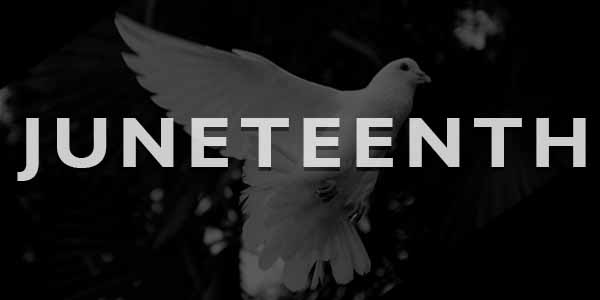
Happy Juneteenth from Sea Mar Community Health Centers.
June 19, 1865 is an historic moment in U.S. history, yet those who are not history aficionados or from the African American community have little understanding of its meaning or significance. Many argue that this date should be as popular as July 4 (U.S. Independence Day) or Memorial Day (celebrated on the last Monday of May). As you will read below, June 19 was not the Emancipation Proclamation issued by President Lincoln in 1863 and not the ratification of the 13th Amendment that officially abolished slavery in the United States in 1865. In an effort to provide information and educate our Sea Mar Community, we provide this short history of Juneteenth, recognized by 47 states as a state or ceremonial holiday, including Washington. Please enjoy reading about one of the most profound moments in U.S. history.
Juneteenth is the oldest nationally celebrated commemoration of the ending of slavery in the United States. It was June 19, 1865 that the Union soldiers, led by Major General Gordon Granger, landed at Galveston, Texas with news that the war had ended and that the enslaved were now free. Note that this was two and a half years after President Lincoln’s Emancipation Proclamation - which had become official January 1, 1863. The Emancipation Proclamation had little impact on the Texans due to the minimal number of Union troops to enforce the new Executive Order. However, with the surrender of General Lee in April of 1865, and the arrival of General Granger’s regiment, the forces were finally strong enough to influence and overcome the resistance.
When Texas fell and Granger dispatched his now famous order No. 3, it was not exactly instant magic for most of the Lone Star State’s 250,000 slaves. On plantations, masters had to decide when and how to announce the news –or wait for a government agent to arrive—and it was not uncommon for them to delay until after the harvest. Even in Galveston city, the ex-Confederate mayor flouted the Army by forcing the freed people back to work, as historian Elizabeth Hayes Turner details in her comprehensive essay, “Juneteenth: Emancipation and Memory,” in Lone Star Pasts: Memory and History in Texas.
One of General Granger’s first orders of business was to read to the people of Texas, General Order Number 3 that began most significantly:
The reactions to this profound news ranged from pure shock to immediate jubilation. While many lingered to learn of this new employer to employee relationship, many left before these offers were completely off the lips of their former 'masters' - attesting to the varying conditions on the plantations and the realization of freedom. Even with nowhere to go, many felt that leaving the plantation would be their first grasp of freedom. North was a logical destination and for many it represented true freedom, while the desire to reach family members in neighboring states drove some into Louisiana, Arkansas and Oklahoma. The celebration of June 19 was coined "Juneteenth" and grew with more participation from descendants. The Juneteenth celebration was a time for reassuring each other, for praying and for gathering remaining family members. Juneteenth continued to be highly revered in Texas decades later, with many former slaves and descendants making an annual pilgrimage back to Galveston on this date.
Ranges of activities were provided to entertain the masses, many of which continue in tradition today. Rodeos, fishing, barbecuing and baseball are just a few of the typical Juneteenth activities you may witness today. Juneteenth usually focused on education and self-improvement. Thus, often guest speakers are brought in and the elders are called upon to recount the events of the past. Prayer services were also a major part of these celebrations.
In the early years, little interest existed outside the African American community in participation in the celebrations. In some cases, there was outwardly exhibited resistance by barring the use of public property for the festivities. Most of the festivities found themselves out in rural areas around rivers and creeks that could provide for additional activities such as fishing, horseback riding and barbecues. Often church grounds were the site for such activities. Eventually, as African Americans became landowners, land was donated and dedicated for these festivities. There are accounts of Juneteenth activities being interrupted and halted by white landowners demanding that their laborers return to work. However, it seems most allowed their workers the day off and some even donated food and money. For decades these annual celebrations flourished, growing continuously with each passing year.
Economic and cultural forces led to a decline in Juneteenth activities and participants beginning in the early 1900’s. Classroom and textbook education in lieu of traditional home and family-taught practices stifled the interest of the youth due to less emphasis and detail on the lives of former slaves. Classroom textbooks proclaimed Lincoln’s Emancipation Proclamation of January 1, 1863 as the date signaling the ending of slavery - and mentioned little or nothing of the impact of General Granger’s arrival on June 19.
The Depression forced many people off the farms and into the cities to find work. In these urban environments, employers were less eager to grant leaves to celebrate this date. Thus, unless June 19 fell on a weekend or holiday, there were very few participants available. July 4th was already the established Independence holiday and a rise in patriotism steered more toward this celebration.
The Civil Rights movement of the 1950’s and 1960’s yielded both positive and negative results for the Juneteenth celebrations. While it pulled many of the African American youth away and into the struggle for racial equality, many linked these struggles to the historical struggles of their ancestors. Student demonstrators involved in the Atlanta civil rights campaign in the early 1960’s, who wore Juneteenth freedom buttons, evidenced this. Again, in 1968, Juneteenth received another strong resurgence through the Poor Peoples March to Washington D.C. Rev. Ralph Abernathy’s call for people of all races, creeds, economic levels and professions to come to Washington to show support for the poor. Many of these attendees returned home and initiated Juneteenth celebrations in areas previously absent of such activities. In fact, two of the largest Juneteenth celebrations founded after this March are held in Milwaukee and Minneapolis.
On January 1, 1980, Juneteenth became an official state holiday through the efforts of Al Edwards, an African American state legislator. The successful passage of this bill marked Juneteenth as the first emancipation celebration granted official state recognition. Edwards has since actively sought to spread the observance of Juneteenth all across America.
Today, Juneteenth is enjoying a phenomenal growth rate within communities and organizations throughout the country. Institutions such as the Smithsonian, the Henry Ford Museum and others have begun sponsoring Juneteenth-centered activities. In recent years, a number of local and national Juneteenth organizations have arisen to take their place alongside older organizations - all with the mission to promote and cultivate knowledge and appreciation of African American history and culture. Juneteenth today, celebrates African American freedom and achievement, while encouraging continuous self-development and respect for all cultures. As it takes on a more national, symbolic and even global perspective, the events of 1865 in Texas are not forgotten, for all of the roots tie back to this fertile soil from which a national day of pride is growing.
The future of Juneteenth looks bright as the number of cities and states creating Juneteenth committees continues to increase. Respect and appreciation for all of our differences grow out of exposure and working together. Getting involved and supporting Juneteenth celebrations creates new bonds of friendship and understanding among all. This indeed brightens the future - and that is the Spirit of Juneteenth.
Information for this article was gleaned from two sources. First, “What is Juneteenth?” by renowned scholar of African American literature and public intellectual, Henry Louis Gates, Jr. Second, the “History of Juneteenth,” by National Registry of Juneteenth Organizations and World Wide Celebrations.
Books
- Are prisons obsolete? By Angela Davis
- Women Race & Class by Angela Davis
- The autobiography of Malcolm X as told to Alex Haley
- Medical Apartheid: The Dark History of Medical experimentation on Black Americans from Colonial Times to the Present by Harriet A. Washington
- My Bondage and My Freedom by Frederick Douglass
- The Fire Next Time by James Baldwin
- Blackballed: The Black Vote and U.S. Democracy by Darryl Pinchney
- Body and Soul: The Black Panther Party and the Fight against Medical Discrimination by Alondra Nelson
- The End of Policing by Alex S. Vitale
- From the War on Poverty to the War on Crime: The Making of Mass Incarceration in America
- How to Be an Anti-Racist, Ibram Kendi
- So You Want to Talk About Race, Ijeoma Oluo
- White Privilege, Paula Rothenberg
- Racisms – A Short History, George M. Fredrickson
- Race Matters, Cornel West
- The Devil’s Highway, Luis Alberto Urrea
- The Tortilla Curtain, T.C. Boyle
- The Burning: Massacre, Destruction, and the Tulsa Race Riot of 1921, Tim Madigan
- Faces at the Bottom of the Well – The Permanence of Racism, Derrick Bell
- The Injustice Never Leaves You: Anti-Mexican Violence in Texas, Monica Muñoz Martinez
- The Rodrigo Chronicles: Conversations About America and Race, Richard Delgado
Kid Books
- All Are Welcome by Alexandra Penfold
- IntersectionAllies: We Make Room For All by Chelsea Johnson, LaToya Council, and Carolyn Choi
- 37 Childrens Books to Help Talk about Racism and Discrimination
English Films
- 13th
- When They See Us
- Selma
- Malcolm X
- The Kalief Browder Story
- The Rise and Fall of Jim Crow
- Let it Fall: Los Angeles 1982-1992
- Stay Woke: The Black Lives Matter Movement
- Do the Right thing
- Fruitvale Station
- Rest in Power: The Trayvon Martin Story
- I Am Not Your Negro
- Explained: The Racial Wealth Gap
- 12 Years a Slave
- Trigger Warning with Killer Mike (Netflix)
- Dear White People (Netflix)
Podcasts
- 1619 from The New York
- Throughline from NPR
- Interesctionality Matters! From The African American Policy Forum
- Crossing Fences
- New Books in African American Studies
- Black History Buff Podcast
- Code Switch
- Affirm
- Historically Black
- Human Archive
- Blackbelt Voices
- Noire Histoir
- Silence is Not an Option with Don Lemon (Podcast)
